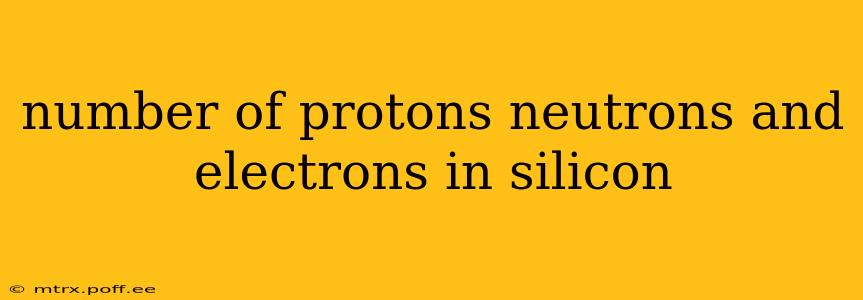Silicon, a cornerstone element in modern technology, boasts a fascinating atomic structure. Understanding its composition—specifically, the number of protons, neutrons, and electrons—is crucial for grasping its properties and applications. This comprehensive guide will delve into the specifics of silicon's atomic makeup, addressing common questions along the way.
How Many Protons Does Silicon Have?
Silicon (Si) has an atomic number of 14. The atomic number represents the number of protons in an atom's nucleus. Therefore, every silicon atom contains 14 protons. This number is fundamental to silicon's identity; it's what defines it as silicon and differentiates it from other elements.
How Many Neutrons Does Silicon Have?
Unlike the consistent number of protons, the number of neutrons in a silicon atom can vary. This leads to the existence of isotopes. The most common isotope of silicon is Silicon-28 (²⁸Si), which contains 14 neutrons. However, other isotopes exist, including Silicon-29 (²⁹Si) with 15 neutrons and Silicon-30 (³⁰Si) with 16 neutrons. The total number of protons and neutrons determines the mass number of the isotope.
How Many Electrons Does Silicon Have?
In a neutral silicon atom, the number of electrons equals the number of protons. This means a neutral silicon atom has 14 electrons. These electrons are arranged in electron shells surrounding the nucleus. The electronic configuration is 1s²2s²2p⁶3s²3p², crucial in determining silicon's chemical behavior and bonding capabilities. This arrangement allows silicon to form four covalent bonds, leading to its extensive use in semiconductor technology.
What are the Different Isotopes of Silicon?
As mentioned earlier, silicon exists in several isotopic forms. These isotopes have the same number of protons (14) but differ in their number of neutrons. The three naturally occurring isotopes are:
- Silicon-28 (²⁸Si): This is the most abundant isotope, comprising approximately 92.2% of naturally occurring silicon. It has 14 protons and 14 neutrons.
- Silicon-29 (²⁹Si): This isotope makes up about 4.7% of naturally occurring silicon. It contains 14 protons and 15 neutrons.
- Silicon-30 (³⁰Si): This is the least abundant naturally occurring isotope, comprising approximately 3.1% of naturally occurring silicon. It has 14 protons and 16 neutrons.
What is the Atomic Mass of Silicon?
The atomic mass of silicon is approximately 28.0855 atomic mass units (amu). This is a weighted average of the masses of the naturally occurring isotopes, taking into account their relative abundances. It's important to note that this is not the mass of a single silicon atom, but rather an average reflecting the isotopic composition found in nature.
How Does the Number of Protons, Neutrons, and Electrons Affect Silicon's Properties?
The number of protons defines silicon's elemental identity and its chemical properties. The number of neutrons influences the isotope's mass and stability. The number of electrons dictates how silicon interacts with other atoms, forming bonds and participating in chemical reactions. The combination of these factors gives silicon its unique semiconductor properties, essential for its widespread use in electronics and other technologies.
This detailed explanation should clarify the number of protons, neutrons, and electrons in silicon and offer a better understanding of its atomic structure and properties. The information provided here reflects current scientific understanding and is intended for educational purposes.
